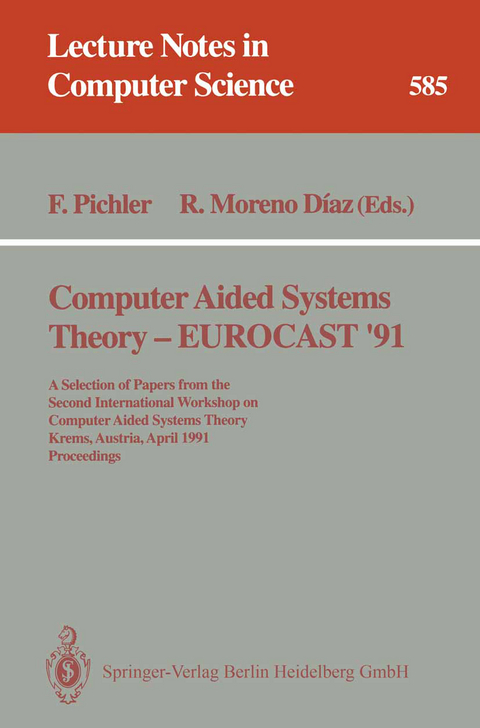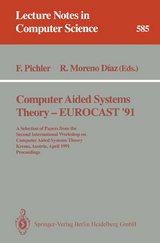Computer Aided Systems Theory - EUROCAST '91
Springer Berlin (Verlag)
978-3-540-55354-0 (ISBN)
Linear and algorithmic formulation of co-operative computation in neural nets.- Algebraic system modelling and implementation.- Towards an "Erlangen program" for general linear systems theory.- Geometric theory of nonlinear dynamical networks.- Multidimensional constant linear systems.- Computer aided analysis and design of time-varying systems.- Towards a computer aided design of linear control systems.- Use of modern computer tools for numerical experiments in Matrix theory.- The concept of the system as a key to system-engineering in the information technology domain.- General Systems Theory requirements for the engineering of complex models.- Control of systems described by means of nonmetric variables.- Object identification and retrieval in a CAST library.- Navigation in Systems Problem Solving.- VisaVis the conception of a functional Visual Programming Language.- Systems theory in modelling chromatic retinal visual processing.- A transformation of the problems of minimal satisfaction of constraints.- Formalizing statistical analysis: Approaches and prospects.- An environment for intelligent autonomous system design and simulation.- Balanced systems: A new approach to integrate hardware and software design.- Systems modeling and process control.- Human-computer interaction and cooperation for supervisory control of large-complex systems.- Incorporating heuristic rules in a multifaceted system.- Towards formalism of deep model descriptions of dynamic systems.- A new approach to the design of concurrent control architectures.- CA-methods for the development and construction of Hydroelectric Power Plants.- Test strategy planning - A tool to support future CAD systems.- On the complexity of system-level diagnostic algorithms.- Bus protocol conversion: Fromtiming diagrams to state machines.- CONSHELL.- Computer Aided Vision (CAV) a cast method bank for artificial vision systems.- A cast system for visual fault detection research.- CAST tools for automatic FMS-Dynamics models synthesis.- CAST.FSM applied to VLSI synthesis: Experimental results and requirements for industrial use.- A high level interactive design environment for complex systems.- The signal description language SIBA.- Experience in the development of advanced modelling environments.- Linking CAST.FSM to practical applications.- The algebraic algorithm A * for the action planning problems.- Complete transforms and their incidence in artificial perception systems theory.- Neural structures to compute homothetic invariances for artificial perception systems.- Systems optimization in retinal research.- Reduced inference systems: Alternative architectures for vision.- Computer Aided Clinical Information System for hospitals.- A methodology for computer aided modelling of information systems based on the extended entity relationship model BIER.- Decision supported systems and their industrial applications.- User interface to a CIM-database.- Artificial intelligence in CIM.- Input-Output model for unconventional sampled-data control systems.- The expediency of syntagmatic objects in CACSD systems.- Automatic robot programming by CAST.- How to achieve perception of real-world scenes: A case study.- Tools for coupling AI and control systems CAD.- An integrated environment for computer-aided control engineering.- Computer aided multi parameter analysis of linear control systems using exponent diagram techniques.- Computer aided multi parameter design of linear systems using exponent diagram techniques.- Minimal realization procedures based on balancing and related techniques.
| Erscheint lt. Verlag | 8.4.1992 |
|---|---|
| Reihe/Serie | Lecture Notes in Computer Science |
| Zusatzinfo | DCCLXXX, 770 p. |
| Verlagsort | Berlin |
| Sprache | englisch |
| Maße | 155 x 235 mm |
| Gewicht | 1062 g |
| Themenwelt | Informatik ► Weitere Themen ► CAD-Programme |
| Schlagworte | algorithms • Artificial Intelligence • CAD • Complexity • Computer Aided Design (CAD) • Computer-Aided Design (CAD) • Computer Aided Systems Theory (CAST) • Computerunterstützte Systemtheorie (CAST) • Construction • control engineering • Hardcover, Softcover / Informatik, EDV/Anwendungs-Software • HC/Informatik, EDV/Anwendungs-Software • HC/Informatik, EDV/Informatik • Information Processing Technology • Informationstechnik • Informationsverarbeitung(EDV) • Informationsverarbeitung_(EDV) • Modellierung (EDV) • Modelling Environments • Optimization • Programming language • Regelung • Regelungstechnik • Regelungstheorie(EDV) • Regelungstheorie_(EDV) • robot • System Modeling • Systemtheorie |
| ISBN-10 | 3-540-55354-1 / 3540553541 |
| ISBN-13 | 978-3-540-55354-0 / 9783540553540 |
| Zustand | Neuware |
| Haben Sie eine Frage zum Produkt? |
aus dem Bereich




